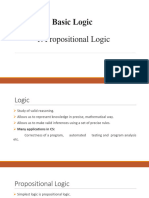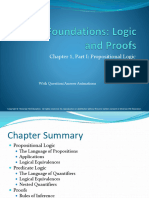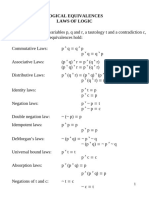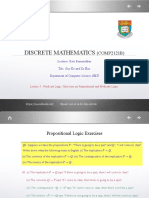Chapter 5 - Logic
Uploaded by
ziyadmohdChapter 5 - Logic
Uploaded by
ziyadmohdChapter 5 Logic
CSNB 143
Discrete Mathematical Structures
OBJECTIVES
Student should be able to know what is it means
by statement.
Students should be able to identify its
connectives and compound statements.
Students should be able to use the Truth Table
without difficulties.
Logic
Statement or proposition is a declarative sentence with
the value of true or false but not both.
Ex 1: Which one is a statement?
The world is round.
2 + 3 = 5
Have you taken your lunch?
3 - x = 5
The temperature on the surface of Mars is 800F.
Tomorrow is a bright day.
Read this!
Statement usually will be replaced by variables
such as
p, q, r or s.
Ex 2:
p: The sun will shine today.
q: It is a cold weather.
Statements can be combined by logical
connectives to obtain compound statements.
Ex 3:
AND (p and q): The sun will shine today and it is
a cold weather.
Connectives AND is what we called conjunction
for p and q, written p q. The compound
statement is true if both statements are true.
Connectives OR is what we called disjunction
for p and q, written p q. The compound
statement is false if both statements are false.
To prove the value of any statement (or
compound statements), we need to use the Truth
Table.
P Q P Q P Q
T T T T
T F F T
F T F T
F F F F
Negation for any statement p is not p. written as
~p or p. The Truth Table for negation is:
Ex 4: Find the value of (~p q) p using Truth
Table.
P P
T F
F T
P Q P P Q ( P Q) P
T T F F T
T F F F T
F T T T T
F F T F F
Conditional Statements
If p and q are statements, the compound
statement if p then q, denoted by p q is called
a conditional statement or implication.
Statement p is called the antecedent or
hypothesis; and statement q is called
consequent or conclusion. The connective if
then is denoted by the symbol .
Ex 5:
a) p : I am hungry q : I will eat
b) p : It is cold q : 3 + 5 = 8
The implication would be: a) If I am hungry,
then I will eat.
b) If it is cold, then 3 + 5 =
8.
Take note that, in our daily lives, Ex 5 b) has no
connection between statements p and q, that is,
statement p has no effect on statement q.
However, in logic, this is acceptable. It shows
that, in logic, we use conditional statements in a
more general sense.
Its Truth Table is as below:
To understand, use: p = It is raining q = I used umbrella
P Q P Q
T T T
T F F
F T T
F F T
Another meaning that use the symbol includes:
if p, then q
p implies q
if p, q
p only if q
p is sufficient for q
q if p
q is necessary for p
If p q is an implications, then the converse of it
is the implication q p, and the contrapositive
of it is ~q ~p.
Ex 6:
p = It is raining q = I get wet
Get its converse and contrapositive.
If p and q are statements, compound statement p
if and only if q, denoted by p q, is called an
equivalence or biconditional.
Its Truth Table is as below:
To understand, use: p = It is raining q = I used
umbrella
Notis that p q is True in two conditions: both p and q are True,
or both p and q are false.
P Q P Q
T T T
T F F
F T F
F F T
Another meaning that use the symbol includes:
p is necessary and sufficient for q
if p, then q, and conversely
In general, compound statement may contain few
parts in which each one of it is yet a statement
too.
Ex 7: Find the truth value for the statement
(p q) (~q ~p)
P Q PQ
(A)
Q P QP
(B)
(A)(B)
T T T F F T T
T F F T F F T
F T T F T T T
F F T T T T T
A statement that is true for all possible values of
its propositional variables is called a tautology.
A statement that is always false for all possible
values of its propositional variables is called a
contradiction.
A statement that can be either true or false,
depending on the truth values of its propositional
variables is called a contingency
Logically Equivalent
Two statements p and q are said to be logically
equivalent if p q is a tautology.
Ex 8: Show that statements p q and (~p) q
are logically equivalent.
Quantifier
Quantifier is used to define about all elements
that have something in common.
Such as in set, one way of writing it is {x | P(x)}
where P(x) is called predicate or propositional
function, in which each choice of x will produces
a proposition P(x) that is either true or false.
There are two types of quantifier being used:
a) Universal Quantification () of a predicate P(x)
is the statement
For all values of x, P(x) is true
In other words:
for every x
every x
for any x
b) Existential Quantification () of a predicate P(x)
is the statement
There exists a value of x for which P(x) is
true
In other words:
there is an x
there is some x
there exists an x
there is at least one x
Theorem 1
Operations on statements are:
Commutative
p q q p
p q q p
Associative
p (q r) (p q) r
p (q r) (p q) r
Distributive
p (q r) (p q) (p r)
p (q r) (p q) (p r)
Idempotent
p p p
p p p
Negations
~(~p) p
~(p q) (~p) (~q)
~(p q) (~p) (~q)
Theorem 2
Operations on implications are:
(p q) ((~p) q)
(p q) ((~q) ~p)
(p q) ((p q) (q p))
~(p q) (p ~q)
~(p q) ((p ~q) (q ~p))
Theorem 3
Operations on quantifier are:
~(x P(x)) x ~P(x)
~(x ~P(x)) x P(x)
x (P(x) Q(x)) x P(x) x Q(x)
x P(x) x Q(x) x (P(x) Q(x))
Anyone can achieve Q if you fulfill P
Even though you satisfy P, only someone can achieve Q
x (P(x) Q(x)) x P(x) x Q(x)
x (P(x) Q(x)) x P(x) x Q(x)
((x P(x)) (x Q(x))) x (P(x) Q(x))
tautology
x (P(x) Q(x)) x P(x) x Q(x)
tautology
Theorem 4
All of these are tautology:
a) (p q) p f) (p q) p
b) (p q) q g) (p (p q)) q
c) p (p q) h) (~p (p q)) q
d) q (p q) i) (~q (p q)) ~p
e) ~p (p q) j) ((p q) (q r)) (p
r)
You might also like
- Chen W (1) .L - Discrete Mathematics Super Cool NotesNo ratings yetChen W (1) .L - Discrete Mathematics Super Cool Notes190 pages
- 5th - Ed - Sect - 2pt1 - Logical - Form - and EquivalenceNo ratings yet5th - Ed - Sect - 2pt1 - Logical - Form - and Equivalence6 pages
- Session 4 - Mathematics in The Modern World-Logic-Biconditional StatementNo ratings yetSession 4 - Mathematics in The Modern World-Logic-Biconditional Statement63 pages
- The Foundations: Logic and Proofs: Chapter 1, Part I: Propositional LogicNo ratings yetThe Foundations: Logic and Proofs: Chapter 1, Part I: Propositional Logic63 pages
- Chapter 1, Part I: Propositional Logic: With Question/Answer AnimationsNo ratings yetChapter 1, Part I: Propositional Logic: With Question/Answer Animations42 pages
- Unisza:taf3023: Discrete Mathematics Presentation 1:forespec GroupNo ratings yetUnisza:taf3023: Discrete Mathematics Presentation 1:forespec Group29 pages
- 3c - Introduction to Logic and Truth TablesNo ratings yet3c - Introduction to Logic and Truth Tables29 pages
- Mathematical Foundations of Computer ScienceNo ratings yetMathematical Foundations of Computer Science83 pages
- Conditional Propositions and Logical Equivalence100% (3)Conditional Propositions and Logical Equivalence30 pages
- Discrete Mathematics and Its Applications by Kenneth H. RosenNo ratings yetDiscrete Mathematics and Its Applications by Kenneth H. Rosen8 pages
- First-Order Logic (FOL) : Aka. Predicate CalculusNo ratings yetFirst-Order Logic (FOL) : Aka. Predicate Calculus44 pages
- Constructing More Extended Formal Proofs: - For A Given Argument As A Sequence of Statements, Each Is Either A Premise ofNo ratings yetConstructing More Extended Formal Proofs: - For A Given Argument As A Sequence of Statements, Each Is Either A Premise of10 pages
- Logical Arithmetic 2: The Sorites: Example 1: GoclenianNo ratings yetLogical Arithmetic 2: The Sorites: Example 1: Goclenian17 pages
- P, Q, R Q P, Q, R: Questions Mark S Co PoNo ratings yetP, Q, R Q P, Q, R: Questions Mark S Co Po2 pages
- Propositional Model Checking using PythonNo ratings yetPropositional Model Checking using Python4 pages
- Department of Computer Science Government College Women University FaisalabadNo ratings yetDepartment of Computer Science Government College Women University Faisalabad14 pages
- The Facts:: Limitation of Propositional LogicNo ratings yetThe Facts:: Limitation of Propositional Logic16 pages
- Discrete Mathematics: Propositional EquivalenceNo ratings yetDiscrete Mathematics: Propositional Equivalence36 pages
- Chen W (1) .L - Discrete Mathematics Super Cool NotesChen W (1) .L - Discrete Mathematics Super Cool Notes
- 5th - Ed - Sect - 2pt1 - Logical - Form - and Equivalence5th - Ed - Sect - 2pt1 - Logical - Form - and Equivalence
- Session 4 - Mathematics in The Modern World-Logic-Biconditional StatementSession 4 - Mathematics in The Modern World-Logic-Biconditional Statement
- The Foundations: Logic and Proofs: Chapter 1, Part I: Propositional LogicThe Foundations: Logic and Proofs: Chapter 1, Part I: Propositional Logic
- Chapter 1, Part I: Propositional Logic: With Question/Answer AnimationsChapter 1, Part I: Propositional Logic: With Question/Answer Animations
- Unisza:taf3023: Discrete Mathematics Presentation 1:forespec GroupUnisza:taf3023: Discrete Mathematics Presentation 1:forespec Group
- Discrete Mathematics and Its Applications by Kenneth H. RosenDiscrete Mathematics and Its Applications by Kenneth H. Rosen
- Mathematical Foundations of Information TheoryFrom EverandMathematical Foundations of Information Theory
- Constructing More Extended Formal Proofs: - For A Given Argument As A Sequence of Statements, Each Is Either A Premise ofConstructing More Extended Formal Proofs: - For A Given Argument As A Sequence of Statements, Each Is Either A Premise of
- Logical Arithmetic 2: The Sorites: Example 1: GoclenianLogical Arithmetic 2: The Sorites: Example 1: Goclenian
- Department of Computer Science Government College Women University FaisalabadDepartment of Computer Science Government College Women University Faisalabad
























































































